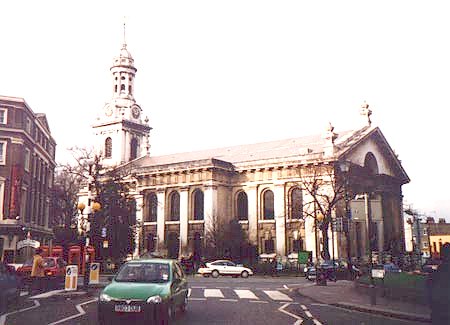|
|
 |
|
Description
of the church
According to Jenkins (England's Thousand Best
Churches) this is one of the first churches to be built under the
Fifty New Churches Act of 1711. It is "turned back to
front" in that the entrance was originally at the east end,
although this is now closed.
The east end consists of a complete Doric portico,
the outer bays blind with pilasters and the central ones open with
full columns. These are crowned by an open pediment with urns.
Flights of steps led up to the oroginal doors. the classical
orders continue on all sides of the grand exterior.
The tower at the west end was added by John James
fifteen years after Hawksmoor's nave was completed. "In
comparison, it is a wimp of a thing."
The interior lacks the drama of Spitalfields, or
even Limehouse. It is dominated by a flat ceiling with a
giant oval panel supported by weak corbels.
The original galleries and woodwork, apparently by
Gibbons, were lost in the War. They were replaced by Albert
Richardson in the 1950s, including the pulpit which imitates the
original. The pulpit isan allarmingly lofty structure, with the
preacher peering down as if from a high diving board. there is
superb wrought ironwork fronting the east galleries.
The benefactor boards are the finest in England, beautifully
lettered and hung on either side of the Sanctuary with the King's
coat of arms above them. This is a local welfare state with royal
blessing. The Sanctuary has trompe l'oeil coffering and a dire
modern east window of 1953. . .
Henry VIII baptised here, General Wolfe and Thomas
Tallis buried here.
|
At about 4.00am on 29 November 1710, as a result of a severe storm, the roof of the church collapsed, one of the supporting piers having been weakened by the numerous excavations undertaken for burial purposes; the tower, however, remained undamaged.
The parishioners petitioned Parliament for £6,000 towards the rebuilding of the church. As a result, it was expressly provided in the Act of the 9th of Queen Anne (1711) that one of the 50 new churches proposed to be built in the Cities of London and Westminster and their suburbs should be in the Parish of Greenwich. All this building was to be financed by a continuation of the Coal Tax, which had been raised to pay for the rebuilding of London after the Great Fire of 1666.
The early church
Nicholas Hawksmoor, a pupil of Sir Christopher Wren, and the Clerk of the Works at Greenwich Hospital for 40 years, was commissioned to design the new church. English Baroque style was practically the creation of the Office of Works in the years after the Restoration; and the building of the new churches gave Hawksmoor his greatest opportunity. The Commissioners gave the architect a free hand, which enabled him to express his ideas about the management of space.
In the interior of St Alfege church, the length is one and one-third times its breadth, and its height is roughly one half of the breadth. The galleries divide the interior and create aisles; they also punctuate, as it were, the space and increase the effectiveness of the whole design.
The Church itself was erected between 1712 and 1714 but consecration was delayed until 29 September 1718. The delay was partly due to the fact that the parishioners took exception to the Church Commissioners' direction that a "seat of distinction" should be provided for the use of the Royal Family. However, after a lapse of six months, the parishioners "became convinced of their error, and were under the necessity of petitioning the Archbishop of Canterbury, and others the Commissioners, requesting, with the most profound humility, that they would be pleased to proceed with the building, and every impediment to the erection of a seat should be removed" (from An Account of the Legacies, Gifts, Rents, Fees etc appertaining to the Church and Poor of the Parish of St Alphege [sic] Greenwich by John Kimbell, September 1816). The Royal Pew was installed in the West gallery.
Hawksmoor's design included a tower but Queen Anne's Commissioners were running short of money, and several petitions by the parishioners were necessary before the Commissioners reluctantly agreed to the economic recasing of the old tower to the design of John James of Greenwich. The tower was completed in 1730; Hawksmoor transferred his design for the tower to St Anne's, Limehouse.
The lists of memorials to royal servants show how rich the interior of this early church must have been. Thomas Tallis was buried beneath the chancel, as was Antony Lyle, one of Queen Elizabeth I's four Gentleman Ushers.
|
|
EXTERNAL & INTERNAL PICTURES REQUIRED PLEASE
|
|
|

|
|
|

|
|
|
|
|
SEARCH THIS SITE |
|
|
This
site has been constructed by, and remains the copyright of,
its authors,
Edwin and Sheila Macadam,
Shelwin, 30, Eynsham Road, Botley,
Oxford OX2 9BP
|
|
| ©
July 2001 -
|
|

